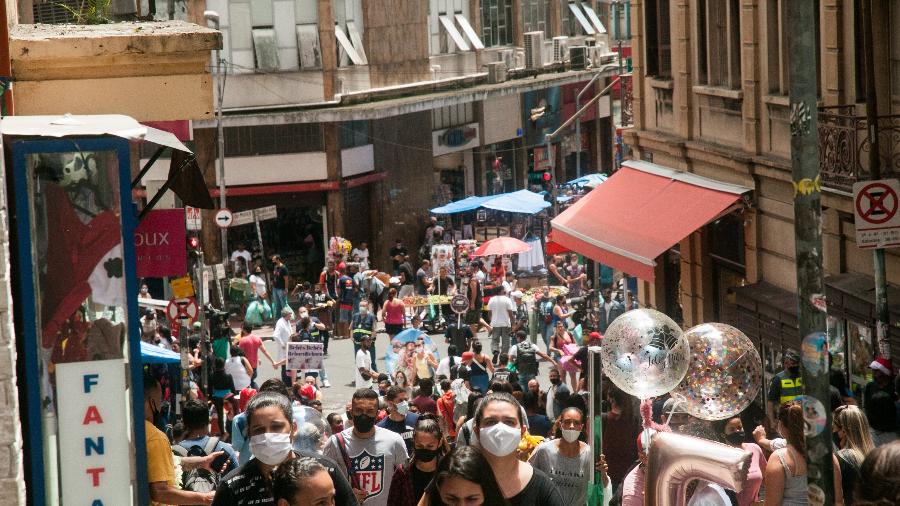SÃO PAULO, BRAZIL – The rolling average of Covid-19 deaths, an indicator that assesses the evolution of the disease based on an average of new deaths over the past seven days, has multiplied four-fold in Greater São Paulo since the first half of November, when the current wave of contagion began. This average stood at 22 daily deaths on November 10th and reached 88 on Friday.
Intensive Care Unit (ICU) occupancy rates in the metropolitan region, also on the rise, have already alerted health authorities to a potential increase in the transfer of critically ill patients, at levels that could compromise the city’s supply of beds.

According to the state government, the rise in deaths is a consequence of the increase in new cases, and there is a government program to expand the number of ICU spaces by 2,000 throughout the state in the coming months.
This week, despite the state having failed to disclose the number of deaths one day on the grounds of a system failure, death figures in Greater São Paulo could place the region in the orange phase, the second strictest of the São Paulo Plan.
However, the João Doria administration reported that the growth was related to a data backlog and that a single indicator would not be enough to prompt the change, since there are seven indexes in total that classify regions.
The ICU bed occupancy rate in the region (the capital and 38 surrounding municipalities), which once stood at less than 41%, rose to 67.5% last Friday, amid an upward trend.
The higher occupancy is both the result of the growth in the number of hospitalizations and the reduction in the amount of ICU beds available – in all cities of Greater São Paulo, these beds were being closed as the crisis subsided and, now, the pace of bed reopening has not been enough to lower this occupancy rate.
In Greater São Paulo, on November 10th (when the growth trend began), when ICU bed occupancy stood at 42%, the rolling average of new hospitalizations stood at 1,814 patients a day. On Friday, it was 2,921 (61% increase). The total ICU beds on that date was 4,062, while it is now 4,330.
Although the supply of beds has already increased, the number of available beds is the lowest since October 8th. There were 4,830 beds at that time, but the rolling average of hospitalizations stood at 1,280, less than half the current rate.
In the capital, according to City Hall data, the number of ICU beds is also lower than in recent months. There are now 966, compared to 1,076 on November 10th, when hospitalizations began to rise again.
Municipal Health Secretary Edson Aparecido stated that the city can easily increase the number, reopening beds on closed floors at Brigadeiro Hospital and other facilities. “But there may be a flood of cases from Greater São Paulo heading here, given that not all cities are reopening beds,” he said.
Roberto Kraenkel, professor at the Institute of Theoretical Physics of the São Paulo State University (UNESP) and member of the Covid-19 BR Observatory, confirms that there is a marked upward trend in the number of hospitalizations in Greater São Paulo, particularly in the Greater ABC industrial suburbs and the capital. “It is rising strongly and in other regions of the state as well,” he says.
The researcher explains that hospitalizations are the most appropriate indicator to analyze the situation of a location in a more urgent way, given that the data on confirmed cases is often lagging in updates.
With the alert for the potential increase in demand for beds in the capital or even the transfer of patients from neighboring cities, the professor notes that this growth, given the current scenario, can not be solely ascribed to this trend. “Proportionally, this should not change the trends they have been experiencing.”
According to Kraenkel, the worsening scenario that has been occurring for over a month is real, although it is growing somewhat slower.
“At the beginning, when the whole population has no immunity, and is susceptible to the disease, growth is very rapid. Now it is growing slower, but an increase can be clearly seen in the majority of regional state Health Secretariats and this can be observed in the national data, which are climbing steadily,” says Kraenkel.
According to him, this is a very dangerous time, and it is necessary to implement urgent measures to prevent contagion and to promote social distancing. “It can involve closing part of commerce, bars, restaurants, gyms and closely monitoring the situation of cases, hospitalizations and deaths in order to then measure how hard this will be. The most successful places were those that took quick action.”
When accepting the growth in the ICU beds occupancy rate in Greater São Paulo, the State Health Secretariat reported in a note that with a 67.5% occupancy, “there are available beds for the population.”
With respect to the migration of patients from other cities to the capital, the Secretariat stated that “it provides full support in organizing patient flows and inter-municipal transfers whenever needed, including residents of São Paulo who need care in services of Greater São Paulo or any other region in the state” and that “every citizen may be assisted in any health service irrespective of their place of residence.”
Regarding the risk of people needing an ICU being deprived of this assistance, the Doria administration argued that “it is not right to correlate the rise in the number of deaths to assistance, given that the network is organized so that all people with severe respiratory distress may be assisted.”
Source: O Estado de S. Paulo

